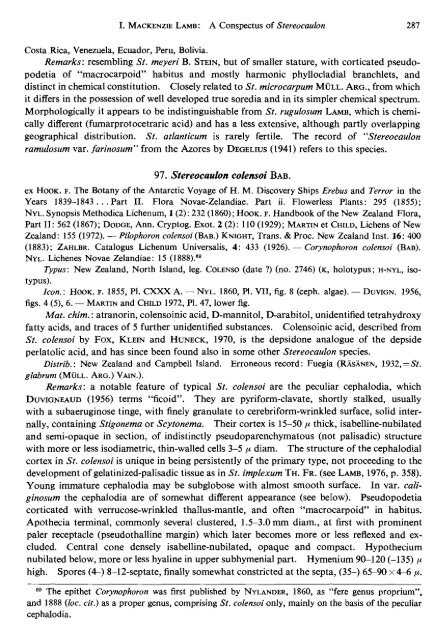A CONSPECTUS OF THE LICHEN GENUS STEREOCAULON ...
A CONSPECTUS OF THE LICHEN GENUS STEREOCAULON ...
A CONSPECTUS OF THE LICHEN GENUS STEREOCAULON ...
Create successful ePaper yourself
Turn your PDF publications into a flip-book with our unique Google optimized e-Paper software.
I. MACKENZIE LAMB: A Conspectus of Stereocaulon 287<br />
Costa Rica, Venezuela, Ecuador, Peru, Bolivia.<br />
Remarks: resembling St. meyeri B. STEIN, but of smaller stature, with corticated pseudopodetia<br />
of "macrocarpoid" habitus and mostly harmonic phyllocladial branchlets, and<br />
distinct in chemical constitution. Closely related to St. microcarpum MULL. ARG., from which<br />
it differs in the possession of well developed true soredia and in its simpler chemical spectrum.<br />
Morphologically it appears to be indistinguishable from St. rugulosum LAMB, which is chemically<br />
different (furnarprotocetraric acid) and has a less extensive, although partly overlapping<br />
geographical distribution. St. atlanticum is rarely fertile. The record of "Stereocaulon<br />
ramulosum var. farinosum" from the Azores by DEGELIUS (1941) refers to this species.<br />
97. Stereocaulon colensoi BAB.<br />
ex HOOK. F. The Botany of the Antarctic Voyage of H. M. Discovery Ships Erebus and Terror in the<br />
Years 1839-1843 . . . Part 11. Flora Novae-Zelandiae. Part ii. Flowerless Plants: 295 (1855);<br />
NYL. Synopsis Methodica Lichenum, 1 (2): 232 (1860); HOOK. F. Handbook of the New Zealand Flora,<br />
Part 11: 562 (1867); DODGE, Ann. Cryptog. Exot. 2 (2): 110 (1929); MARTIN et CHILD, Lichens of New<br />
Zealand: 155 (1972). - Pilophoron colensoi (BAB.) KNIGHT, Trans. & Proc. New Zealand Inst. 16: 400<br />
(1 883) ; ZAHLBR. Catalogus Lichenum Universalis, 4 : 433 (1 926). - Corynophoron colensoi (BAB).<br />
NYL. Lichenes Novae Zelandiae: 15 (1888).80<br />
Typus: New Zealand, North Island, leg. COLENSO (date ?) (no. 2746) (K, holotypus; H-NYL, isotypus).<br />
Icon. : HOOK. F. 1855, PI. CXXX A. - NYL. 1860, PI. VII, fig. 8 (ceph. algae). - DUVIGN. 1956,<br />
figs. 4 (3, 6. - MARTIN and CHILD 1972, PI. 47, lower fig.<br />
Mat. chim. : atranorin, colensoinic acid, D-mannitol, D-arabitol, unidentified tetrahydroxy<br />
fatty acids, and traces of 5 further unidentified substances. Colensoinic acid, described from<br />
St. colensoi by Fox, KLEIN and HUNECK, 1970, is the depsidone analogue of the depside<br />
perlatolic acid, and has since been found also in some other Stereocaulon species.<br />
Distrib. : New Zealand and Campbell Island. Erroneous record: Fuegia (RASANEN, 1932, =St.<br />
glabrum (MOLL. ARG.) VAIN.).<br />
Remarks: a notable feature of typical St. colensoi are the peculiar cephalodia, which<br />
DUVIGNEAUD (1956) terms "ficoid". They are pyriform-clavate, shortly stalked, usually<br />
with a subaeruginose tinge, with finely granulate to cerebriform-wrinkled surface, solid internally,<br />
containing Stigonema or Scytonema. Their cortex is 15-50 p thick, isabelline-nubilated<br />
and semi-opaque in section, of indistinctly pseudoparenchymatous (not palisadic) structure<br />
with more or less isodiametric, thin-walled cells 3-5 p diam. The structure of the cephalodial<br />
cortex in St. colensoi is unique in being persistently of the primary type, not proceeding to the<br />
development of gelatinized-palisadic tissue as in St. implexum TH. FR. (see LAMB, 1976, p. 358).<br />
Young immature cephalodia may be subglobose with almost smooth surface. In var. caliginosum<br />
the cephalodia are of somewhat different appearance (see below). Pseudopodetia<br />
corticated with verrucose-wrinkled thallus-mantle, and often "macrocarpoid" in habitus.<br />
Apothecia terminal, commonly several clustered, 1.5-3.0mm diam., at first with prominent<br />
paler receptacle (pseudothalline margin) which later becomes more or less reflexed and excluded.<br />
Central cone densely isabelline-nubilated, opaque and compact. Hypothecium<br />
nubilated below, more or less hyaline in upper subhymenial part. Hymenium 9LL120 (-135) p<br />
high. Spores (4) 8-12-septate, finally somewhat constricted at the septa, (35-) 65-90 x 4-6 p.<br />
@@ The epithet Corynophoron was first published by NYLANDER, 1860, as "fere genus proprium",<br />
and 1888 (loc. cit.) as a proper genus, comprising St. colensoi only, mainly on the basis of the peculiar<br />
cephalodia.

















